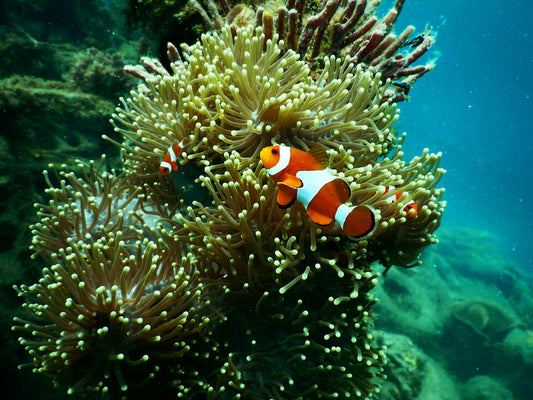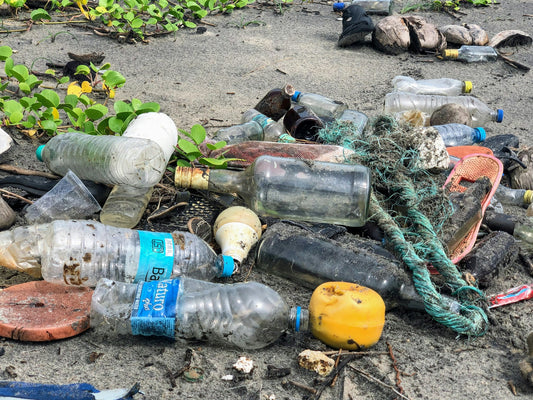Share
Microplastics are small plastics formed from the degradation of larger plastics. They are used in cosmetics, apparel, and packaging.
Because of their small size, microplastics can enter the human body through ingestion, inhalation, and dermal absorption.
Once inside the human body, they can circulate in the bloodstream and access different organs.
A shocking recent research paper revealed that microplastic is even found in human testicles and could be the reason for global infertility trends.
The Shocking Discovery for Men's Health

An academic research paper in the Toxicological Sciences journal by the University of New Mexico has confirmed Microplastics in Human Testicular Tissues for the first time.
A recent study conducted a testicular biopsy on 23 men samples and 47 dog samples and identified microplastic particles in all the test samples.
The researchers found 12 categories of microplastics, and the samples contained an average of 329. 44 micrograms per gram of tissue, which is almost three times higher than in canine samples, which were also analyzed.
The lead researcher of this study, Dr. Xiaozhong Yu, said, “Our research showed that microplastics are present in all human and canine testes and may be related to the global reduction in sperm count in men.”
The scientific community has long been ringing the alarm because of the alarming health impacts of plastics.
Because of the bad health impact of plastics on the human body, researchers are woried that the study could explain a global decline in mens' sperm count and rising infertility issues.
After all, it is without a doubt a good idea to limit the exposure to microplastics, wherever possible.
The Pathways to Exposure of Microplastics
Microplastics enter the human body through various pathways, including:
Ingestion:

Food and Water Contamination:
Microplastics have been found in various foods, such as fish, salt, bees, and beer. A study suggests that human beings ingest 39,000 to 52,000 microplastics annually in food and drink.
Bioaccumulation in Seafood:
Filter feeders such as mussels and oysters become hosts to the microplastic particles in the marine environment.
These microplastics are ingested and later transported into the human body. IUCN research points out that close to 80% of the microplastics in marine ecosystems are transferred from land-based sources and later ingested by humans.
Inhalation:
Investigations have revealed that microplastics exist in the atmosphere and are more concentrated in the cities.
These particles can be inhaled and deposited at different levels of the respiratory tract. A study in Science Advances found that microplastic fibers are present in indoor air from dust and fabrics that contain synthetics.
Dermal Contact:
Some of the most common products with microbeads include soaps, scrubs, and other personal care products like toothpaste. When using these products, some of these particles can be ingested through the skin.
According to the European Chemical Agency (ECHA), microbeads can penetrate the skin and be transported to the bloodstream, thereby presenting certain risks.
What Health Complications Can Microplastics Cause?

Hormonal Disruption
Endocrine-Disrupting Chemicals (EDCs):
As we know, microplastics often contain EDCs like phthalates and bisphenol A (BPA), which disrupt endocrine function.
The Endocrine Society has described EDCs as substances that can imitate or bind to the body’s hormone receptors and interfere with the proper functioning of the endocrine system and, particularly, the reproductive system.
Testosterone Levels:
EDCs can impact the hormonal balance and, in particular, testosterone levels by reducing testosterone production. Testosterone deficiency in the body can lead to low sex drive, difficulty in getting an erection, and other related problems.
Inflammation and Tissue Damage
Immune Response:
Microplastics have the ability to elicit an immune response, which results in inflammation and tissue injury.
Research reveals that microplastics impact human lung cells by increasing oxidative stress and inflammation.
Cellular Damage:
Testicular inflammation, in particular, can lead to spermatogenesis, the process of producing sperm. This can lead to low sperm production as well as poor-quality sperm, which means that the man could be infertile.
DNA Damage
Oxidative Stress:
Microplastics can release reactive oxygen species (ROS), which results in oxidative stress and DNA damage. This can lead to mutations and even cancer, as has been seen in experiments conducted on rats.
A research article in the journal Science of the Total Environment revealed that microplastics affected the oxidative stress and genotoxicity of marine life, and it is expected that humans also experience the same thing.
Testicular Cancer:
Damage to DNA within cells in the testes can cause an increase in the occurrence of testicular cancer.
It has been noted that environmental pollutants may be associated with testicular cancer, and microplastics may be potential pollutants.
Impact on Sperm Quality:
Sperm Count:
More and more investigations have established that environmental pollution, especially by microplastics, reduces sperm concentration.
A meta-analysis conducted in Human Reproduction Update revealed a sharp drop in sperm count worldwide, which could be associated with the effects of microplastics and other environmental pollutants.
Sperm Motility and Morphology:
Depending on the concentration, microplastics may impair sperm quality, including motility and morphology, thus making it difficult for sperm to fertilize an egg.
Some of the effects of EDCs include alteration of sperm shape and movement, and this is evidenced by the high rate of infertility in men.
What Can Be Done To Minimize The Impact of Microplastics on Human Health?
The presence of microplastics in men’s testicles is a clear indication that plastic pollution has infiltrated our bodies and may be affecting our reproductive system.
To manage these risks, it is necessary to use both personal and systemic approaches.
Avoiding single-use plastics and using reusable plastics can also reduce the amount of plastics that are being dumped and helps limit your personal exposure to microplastics.
By focusing on plastic-free products, especially in your kitchen and bathroom, you can significantly reduce your risk ofingesting these harmful particles.

This natural dish wash set will reduce your exposure and consumption of harmful microplastic particles
These Kitchen Starter Kits will kickstart your journey to a life without microplastic.
Additionally, promoting scientific research and demanding more severe measures against plastic production and recycling are fundamental actions to solve the problem.
Enhancing the current waste management systems to increase the recovery and reuse of plastic waste can be effective in avoiding the continued pollution of the environment.
Consumers should be informed about the sources of microplastics to allow them make better choices about their lifestyle.
Finally, research and development of technologies for eliminating microplastics (e.g., through water filtration) and replacing plastic materials is essential to tackle this issue.
We hope you enjoyed this article. If you want to read more like this, make sure to check out our Blog and follow us on Instagram. If you are interested in truly sustainable products, check out our Shop.
Did you know about this shocking revelation? Leave a comment below and engage in the discussion!








